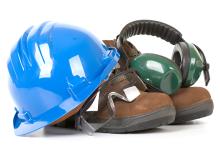
RSSQuarrying remains a dangerous industry in which to work and since 2000 nearly 3,500 workers have reported an injury to the UK’s HSE (Health and Safety Executive), 29 of which were fatal.
However, each year globally many more people are involved in accidents in quarries, and the recent
In the UK, which has one of the best safety records in the world, the Quarry National Joint Advisory Committee (QNJAC) produces guidance and information, and motivates the sector to achieve health and safety improvements through its Target Zero initiative. Its key objective is to reduce injuries by 15% year-on-year up to 2015 from 2010 baseline.
The resulting peer pressure and drive for improvements has led to free exchange of health and safety information between members.
All major players in the industry have signed up to the Target Zero campaign.
So it is the aim of every quarry operator to achieve a zero accident rate, and this is where PPE (a must at every UK quarry and many in Europe) becomes essential.
The difference between an accident causing life-threatening injuries and minor injuries can often be making sure that the workforce is equipped with the correct PPE, and providing such equipment requires a careful risk assessment.
For example, consideration needs to be given to questions such as is the PPE appropriate for the risks present; is it appropriate for the conditions in which it is to be used; will it help to prevent or control the risk without increasing the overall level of risk and can it be adjusted to fit the wearer correctly?
There are other questions, but the selected equipment has to be checked to make sure that it is suitable for the application, and it is important that all users know why they need to wear it, when they need to wear it and how they need to wear it.
For example, Arco, a leading supplier of PPE and workwear, offers a range of respiratory, head, hand and foot protection specifically designed to target zero harm in high risk industries such as quarrying, construction and recycling.
It exhibited for the first time at this year’s Hillhead where its safety experts demonstrated its range of products which offer protection for workers in these environments.
“Arco Training & Consultancy also provides bespoke safety advice for the quarrying and aggregates sectors as part of its consultancy services, ensuring that businesses are fully compliant, helping to create safer workplaces,” says the company.
Other companies involved in the PPE business also exhibited, and pointed out that equipment must also be properly maintained and stored.
In most regions in Europe the level of PPE required in quarry operations is set by national legislation, but major international quarry operators such as
Indeed, only recently Lafarge India was awarded the coveted Golden Peacock Occupational Health and Safety Award by Dr Karan Singh, Member of Parliament. The award was received by the Lafarge senior management team at the award ceremony organised in New Delhi.
Lafarge India bagged the award for its integrated approach and making significant achievements in the field of Occupational Health and Safety.
Speaking at the award ceremony, Ujjwal Batria, managing director, cement, Lafarge India said: “This award is a recognition of our initiatives and stands testimony of our belief that through continuous efforts safety culture can be inculcated across all levels and the goal of Zero Accident can be achieved in the manufacturing sector.”
Another senior Lafarge employee, Maruti Srivastava, area manager, Mumbai, Lafarge Aggregates & Concrete, said: “My number one priority is safety. If I go to any of my plants, we often go to every plant, we see that people are wearing all necessary PPEs: hard hat, reflective jacket, vest, so when you go into an environment where people are wearing all safety equipment, you feel safe, you feel that the company cares for you.”
As in this case it is essential that regular checks on the use of PPE are carried out to make sure that it is being used and if not, why not?.
RSS








